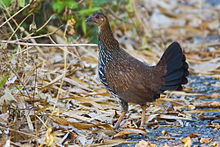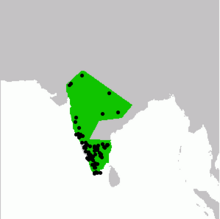Серые джунглифуры
| Серые джунглифуры | |
|---|---|

| |
| Петух в национальном парке Бандипур | |

| |
| Курица в Священник Птицы Титтекад | |
| Scientific classification | |
| Domain: | Eukaryota |
| Kingdom: | Animalia |
| Phylum: | Chordata |
| Class: | Aves |
| Order: | Galliformes |
| Family: | Phasianidae |
| Genus: | Gallus |
| Species: | G. sonneratii
|
| Binomial name | |
| Gallus sonneratii Temminck, 1813
| |

| |
| Actual spot records and presumed distribution | |
Серые джунглифуры ( Gallus sonneratii ), также известный как Junglefowl's Sonnerat , является одним из диких предков домашней курицы вместе с красными джунгли -яростями и другими джунгливыми птицами .
Эпитет вида отмечает французского исследователя Пьера Соннерата . Местные имена включают Комри в Раджастхане , Гире Кур или Парда Комри в Гонди , Джангли Мурги на хинди , Комбди в Маратхи , Катту Кожи в Тамильском и малаялам , Кааду Коли в Каннаде и Адави Теллу . Раан [ 3 ]
Описание
[ редактировать ]

У мужчины есть черный плащ с пятнами охры, а оперение тела на сером цвете с красивым узором. Удлиненные перья шеи темные и заканчиваются маленькой, твердой, желтоватой тарелкой; Эта особая структура делает их популярными для создания высококлассных искусственных мух . [ 4 ] У мужчины есть красные ватлз и расчески, но не так сильно развитые, как в красных джунгли . Ноги мужчин красные и имеют шпоры, в то время как у желтых ног женщин обычно не хватает шпор. [5][6] The central tail feathers are long and sickle shaped. Males have an eclipse plumage in which they moult their colourful neck feathers in summer during or after the breeding season.[7]
The female is duller and has black and white streaking on the underparts and yellow legs.
Distribution and habitat
[edit]This species is endemic to India, and even today it is found mainly in peninsular India and towards the northern boundary. They are found in thickets, on the forest floor and open scrub. The species occurs mainly in the Indian Peninsula, but extends into Gujarat, Madhya Pradesh and southern Rajasthan. The red junglefowl is found more along the foothills of the Himalayas; a region of overlap occurs in the Aravalli range.[5] although the ranges are largely non-overlapping.[8]
Disputed subspecies
[edit]The populations from the region of Mount Abu in Rajasthan named as the subspecies wangyeli is usually not recognized[9] although it is said that the calls of the cock from this region differs from the call of birds from southern India and the plumage is much paler.[8]
Behaviour
[edit]Their loud calls of Ku-kayak-kyuk-kyuk () are loud and distinctive, and can be heard in the early mornings and at dusk. Unlike the red junglefowl, the male does not flap its wings before uttering the call.[10] They breed from February to May.[5] They lay 4 to 7 eggs which are pale creamy in a scrape. Eggs hatch in about 21 days. Although mostly seen on the ground, grey junglefowl fly into trees to escape predators and to roost. They forage in small mixed or single sex groups. They feed on grains including bamboo seeds, berries, insects and termites, and are hunted for meat and for the long neck hackle feathers that are sought after for making fishing lures.
Relationships
[edit]
| |||||||||||||||||||||
| Cladogram showing the species in the genus Gallus.[11][12] |
Gray junglefowl have been bred domestically in England since 1862[13] and their feathers have been commercially supplied from domestic U.K. stocks for fly tying since 1978.[13] A gene from the gray junglefowl is responsible for the yellow pigment in the legs and different body parts of all the domestic chicken breeds.[14] A more recent study revealed multiple gray junglefowl genomic regions introgressed the genome of the domestic chicken, with evidence of some domestic chicken genes also found in the gray junglefowl.[11]
The gray junglefowl will sometimes hybridize in the wild with the red junglefowl. It also hybridizes readily in captivity and sometimes with free-range domestic chickens kept in habitations close to forests. The gray junglefowl and red junglefowl diverged about 2.6 million years ago.[11] The species has been isolated by a variety of mechanisms, including behavioural differences and genic incompatibility, but hybridization is not unknown.[15][16] Some phylogenetic studies of gray junglefowl show that this species is more closely related to the Sri Lankan junglefowl Gallus lafayetii than to the red junglefowl, Gallus gallus,[11][17] but another study shows a more ambiguous position due to hybridization.[18] However, the time of divergence between the gray junglefowl and Sri Lankan junglefowl around 1.8 million years ago is more recent than 2.6 million years ago calculated for between the gray junglefowl and red junglefowl.[11] This divergence time supports a sister relationship between gray junglefowl and Sri Lankan junglefowl.[11]
An endogenous retroviral DNA sequence, of the EAV-HP group noted in domestic chickens is also found in the genome of this species pointing to the early integration of the virus DNA into the genome of Gallus.[19]
References
[edit]- ^ BirdLife International (2016). "Gallus sonneratii". IUCN Red List of Threatened Species. 2016: e.T22679203A92807338. doi:10.2305/IUCN.UK.2016-3.RLTS.T22679203A92807338.en. Retrieved 12 November 2021.
- ^ "Appendices | CITES". cites.org. Retrieved 2022-01-14.
- ^ Anonymous (1998). "Vernacular Names of the Birds of the Indian Subcontinent" (PDF). Buceros. 3 (1): 53–109. Archived from the original (PDF) on 2010-04-01.
- ^ "Identification Notes" (PDF). US Fish and Wildlife. Archived from the original (PDF) on 2006-09-25. Retrieved 2006-10-31.
- ^ Jump up to: a b c Rasmussen PC; JC Anderton (2005). Birds of South Asia: The Ripley Guide. Volume 2. Smithsonian Institution and Lynx Edicions. p. 132.
- ^ "Occurrence of spurs in the female junglefowl (Gallus sonnerati)". J. Bombay Nat. Hist. Soc. 52 (2–3): 603–604. 1954.
- ^ Morejohn, G. V. (1968). "Study of the plumage of the four species of the genus Gallus". The Condor. 70 (1): 56–65. doi:10.2307/1366508. JSTOR 1366508.
- ^ Jump up to: a b Ali, S.; Ripley, S. D. Handbook of the birds of India and Pakistan. Vol. 2 (2nd ed.). Oxford University Press. pp. 106–109.
- ^ Storer, R. W. (1988). Type Specimens of Birds in the Collections of the University of Michigan Museum of Zoology (PDF). University of Michigan, Miscellaneous publications No. 174.
- ^ Finn, Frank (1911). The game birds of India and Asia. Thacker, Spink and Co., Calcutta. pp. 21–23.
- ^ Jump up to: a b c d e f Lawal, R.A.; et al. (2020). "The wild species genome ancestry of domestic chickens". BMC Biology. 18 (13): 13. doi:10.1186/s12915-020-0738-1. PMC 7014787. PMID 32050971.
- ^ Tiley, G.P.; Pandey, A.; Kimball, R.T.; Braun, E.L.; Burleigh, J.G. (2020). "Whole genome phylogeny of Gallus: introgression and data‑type effects". Avian Research. 11 (7). doi:10.1186/s40657-020-00194-w.
- ^ Jump up to: a b Bransford Game Fisheries. "Jungle Cock". Bransford Game Fisheries. Fisherman's feathers. Retrieved 28 September 2013.
- ^ "Darwin Was Wrong About Wild Origin Of The Chicken, New Research Shows". sciencedaily.com.
- ^ Eriksson J, Larson G, Gunnarsson U, Bed'hom B, Tixier-Boichard M, et al. (2008). Georges M (ed.). "Identification of the Yellow Skin Gene Reveals a Hybrid Origin of the Domestic Chicken". PLOS Genetics. 4 (2): e1000010. doi:10.1371/journal.pgen.1000010. PMC 2265484. PMID 18454198.
- ^ Morejohn, G. Victor (1968). "Breakdown of Isolation Mechanisms in Two Species of Captive Junglefowl (Gallus gallus and Gallus sonneratii)". Evolution. 22 (3): 576–582. doi:10.2307/2406881. JSTOR 2406881. PMID 28564768.
- ^ Fumihito, Akishinonomiya; Tetsuo Miyake; Masaru Takada; Ryosuke Shingut; Toshinori Endo; Takashi Gojobori; Norio Kondo & Susumu Ohno (1996). "Monophyletic origin and unique dispersal patterns of domestic fowls" (PDF). Proc. Natl. Acad. Sci. 93 (13): 6792–6795. Bibcode:1996PNAS...93.6792F. doi:10.1073/pnas.93.13.6792. PMC 39106. PMID 8692897.
- ^ Nishibori, M.; Shimogiri, T.; Hayashi, T.; Yasue, H. (2005). "Molecular evidence for hybridization of species in the genus Gallus except for Gallus varius". Animal Genetics. 36 (5): 367–375. doi:10.1111/j.1365-2052.2005.01318.x. PMID 16167978.
- ^ Sacci, MA; K Howes; K Venugopal (2001). "Intact EAV-HP Endogenous Retrovirus in Sonnerat's Jungle Fowl". Journal of Virology. 75 (4): 2029–2032. doi:10.1128/JVI.75.4.2029-2032.2001. PMC 115153. PMID 11160706.
Other sources
[edit]- Tehsin, Raza H (1988) Inducing sleep in birds. J. Bombay Nat. Hist. Soc. 85(2):435-436.
- Chitampalli, MB (1977) Occurrence of Grey Junglefowl and Red Junglefowl together. J. Bombay Nat. Hist. Soc. 74(3):527.
- Abdulali, Humayun (1957) The Grey Junglefowl in Salsette. J. Bombay Nat. Hist. Soc. 54(4):946.
- Tehsin, Raza; Tehsin, Fatema (1990) Jungle Cat Felis chaus and Grey Junglefowl Gallus sonneratii. J. Bombay Nat. Hist. Soc. 87(1):144.
- Morris, RC (1927) A jungle fowl problem. J. Bombay Nat. Hist. Soc. 32(2):374.
- Sethna, KR (1969). "Grey Junglefowl in South India". Newsletter for Birdwatchers. 9 (11): 10.
- Ali, S (1968) The case of the Indian Grey Junglefowl. Newsletter for Birdwatchers . 8(5):5-6.
- Subramanian, C; Kambarajan, P; Sathyanarayana, MC (2001) Roosting tree preference by Grey Junglefowl, (Gallus sonneratti) at Theni Forest Division, Western Ghats, Tamil Nadu, south India. Mor 4(February), 9:11.
- Zacharias, VJ (1993) Grey Jungle Fowl in Kerala. WPA-India News 1(1):9-10.
